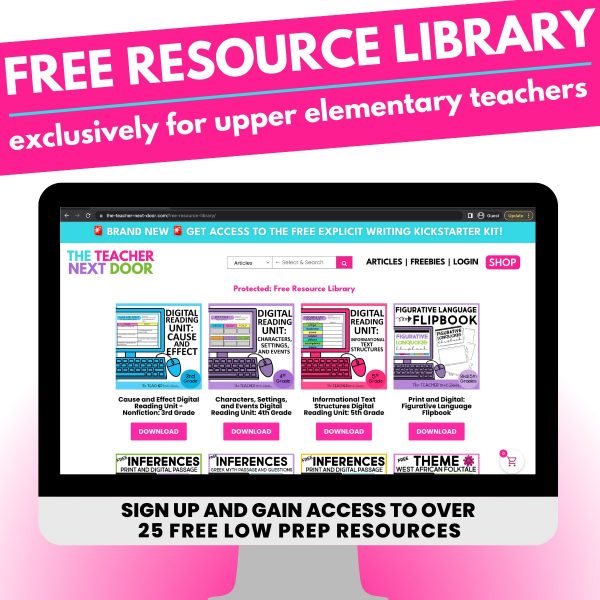
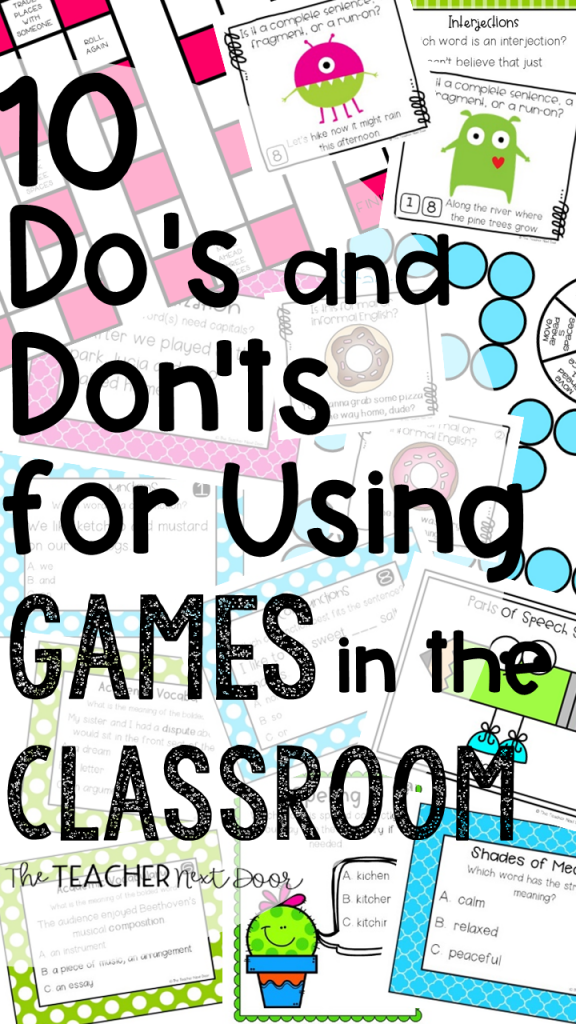
Are you using games in the classroom? Research has shown that games can have a huge impact on student learning! Not only are games a great way to increase engagement, but they give kids a chance to practice social skills while reinforcing learning.
Want to get the most mileage out of game time?
Here is a list of 10 Do’s and Don’ts for Using Games in the Classroom:
1. Do make sure all students know how to play the game.
This may seem basic but without some work on the front end, students will waste learning time trying to figure things out. You’ll definitely want to explain and possibly even model how to play the specific game they’ll be using.
2. Don’t forget to give clear instructions and expectations.
Besides knowing how to play the game, you’ll want kids to know a few specifics.
Here are a few things they’ll need to know:
A. What to do if there’s a conflict
B. What noise level is okay
C. What to do if they finish early
D. How to put the game away properly
E. Where to turn in record sheets (if there are any)
3. Do encourage positive student interactions.
One of the best parts of games is the chance for students to practice social skills like communication, cooperation, and good sportsmanship.
These are actually great topics for Morning Meetings or classroom discussions. You can do activities, like an interactive “accountability talk” anchor chart or do a thumbs up/thumbs down with sportsmanship scenarios to reinforce these ideas.
4. Do set up the game to maximize student involvement.
One of my favorite teaching philosophies is to structure activities so as many students are as involved as possible. That’s one reason I like activities like whiteboards or Four Corners, so everyone is participating.
During game time, I like to set up the games so all of the players are participating if possible, rather than having one playing while the others are looking on. You can do this in a few ways.
For example, you could have all students answer the question and each player shows the answer on a whiteboard. Whoever gets the answer right can roll/spin/move. Another idea is to have one player answer the question while the other players also solve to confirm/disprove that answer.
5. Don’t allow too much unstructured time.
When kids are engaged, they’re less likely to be off-task. Minimizing unstructured time can really help with this too.
To minimize off-task behavior during game time:
A. Keep the game time fairly short. I suggest 15 – 20 minutes depending upon the game and your group of students.
B. Maximize student involvement (see #4 above)
C. Create small groups carefully to decrease unproductive play (or chaos!).
6. Do set up smaller groups of 2 – 3 students per game if possible.
For upper elementary students, a small group of 2 – 3 is the perfect size for most games. That way, all students can access the game materials, and there is less possibility for a student to check out and not participate.
7. Don’t be afraid to use the same game format several times.
Since it does take a bit of time to explain a new game format to students, it’s nice to have a game format you can use again and again with different content. Once kids are comfortable with formats like tic-tac-toe, clip and flip cards, Four-In-A-Row, and a simple roll and move board game format, it’s much easier for them to start playing the game right away on their own.
8. Do decide if student accountability is important or if the process is enough.
This is something you’ll want to think about before explaining the game to students. Do you want to use a record sheet for each student so you can see what they did during game time? Do you want a group record sheet that everyone contributed to? Or do you feel that the process for this game is enough?
There is no one right answer and you may find yourself using a combination of these three methods depending upon the concept or the students in your class.
9. Do incorporate games on a regular basis.
One of the hallmarks of effective teaching is using a variety of teaching and learning methods in the classroom. A teacher who only lectures, or only has students read from textbooks, is probably not going to engage students as much as one who varies the types of activities students experience. Games are a great learning tool, so why not use them often?
Here are a few ways to incorporate games:
A. Use games at centers.
B. Use games as a review (or as a spiral review)
C. Use games regularly once a week – like Game Day Friday!
D. Use games for test prep.
E. Set out games for early finishers.
10. Do choose quality games to reinforce learning.
To make the most of game time, make sure to choose games that are aligned to standards and that target whatever concepts students need the most.
I love using games in the classroom and have created lots of games over the years since I’ve seen how much they boost learning and how much kids enjoy them.
If you want to save time with ready-made learning games, here are a few I would recommend:

20 Reading Games for 3rd Grade

20 Reading Games for 4th/5th Grade
30 Grammar Games for 3rd Grade
30 Grammar Games for 4th Grade
30 Grammar Games for 5th Grade
Here are a few blog posts about games that might be helpful:
How to Use Task Cards With Board Games
Why You Should be Using Games in the Classroom
Thanks so much for stopping by!



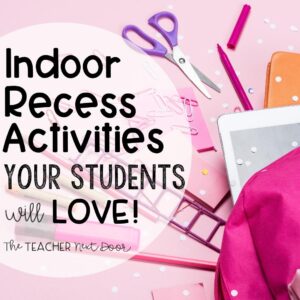
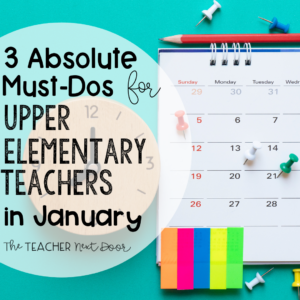

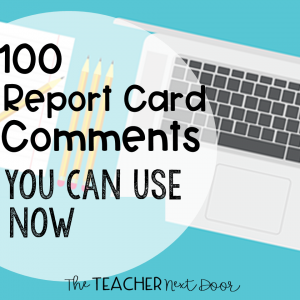

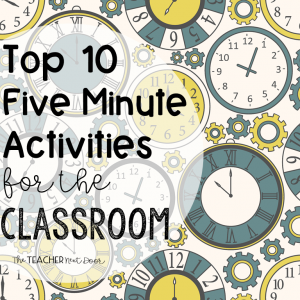


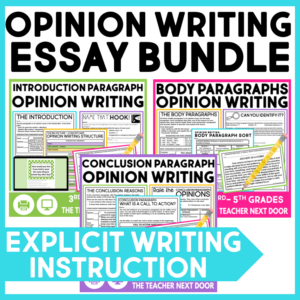

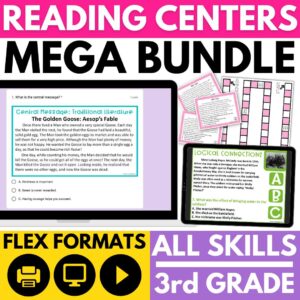
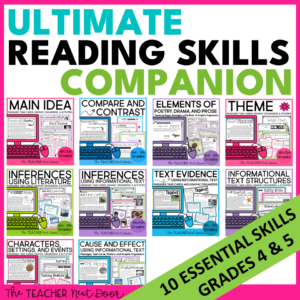
![DAY THREE DROPS! ⬇️⬇️⬇️
👉 Today, you can…
✔️ Grab done-for-you resources to keep your students engaged for $3
✔️ Grab FREE instant download activities!
✔️ Grab all of this week’s deals if you missed any!
ALL 5 of these comprehensive resources from my shop are $3 today to help fight spring fever in your classroom! 🌸🌼🌷
✏️ [BRAND NEW] Step-By-Step Personal Narrative Unit
✏️ Paired Texts Fiction to Nonfiction for Spring
✏️ 4th Grade Morphology & Vocabulary Unit
✏️ Main Idea Unit for 4th & 5th Grades
✏️ Figurative Language Complete Unit for Busy Teachers
Want the link to all the deals and freebies? Comment APRIL PARTY and we’ll send it directly to your DMs! 📫💌
PS - Don’t forget that you can still access all the Day 1 and Day 2 Deals too! 🩷](https://the-teacher-next-door.com/wp-content/plugins/instagram-feed/img/placeholder.png)

